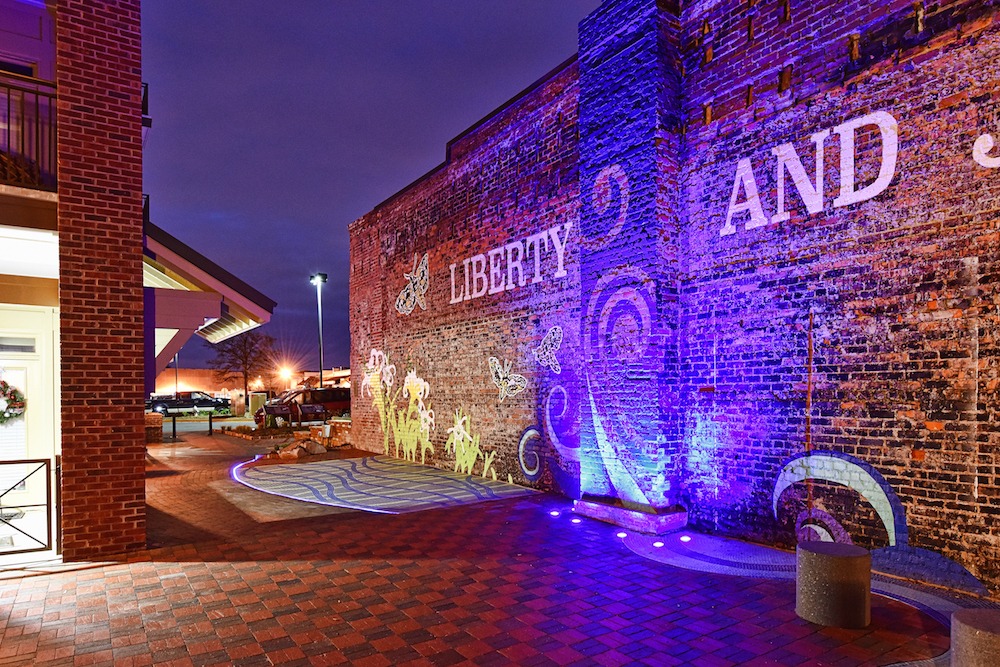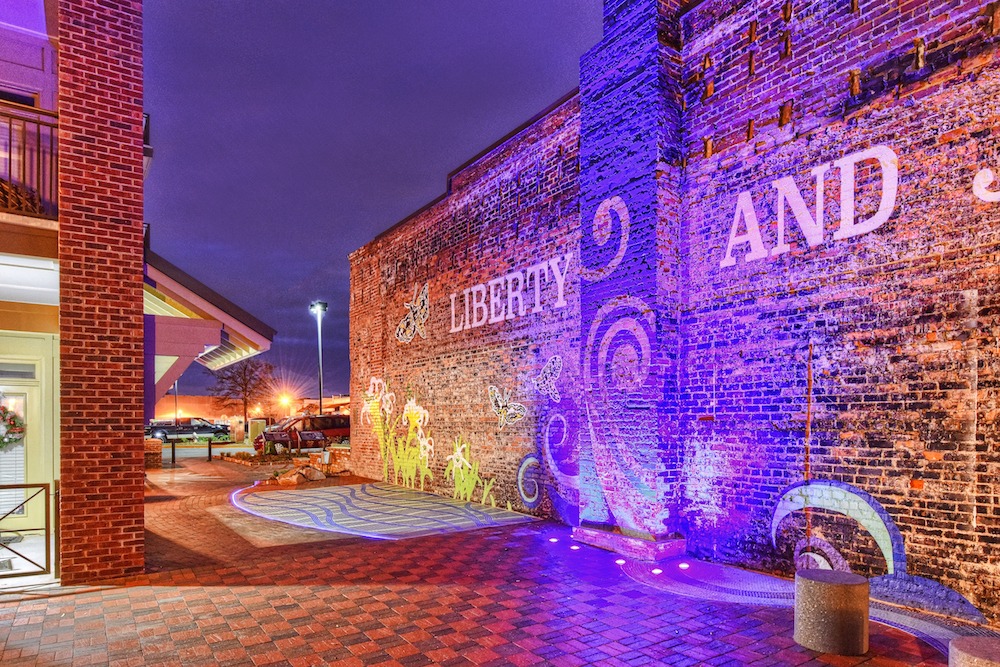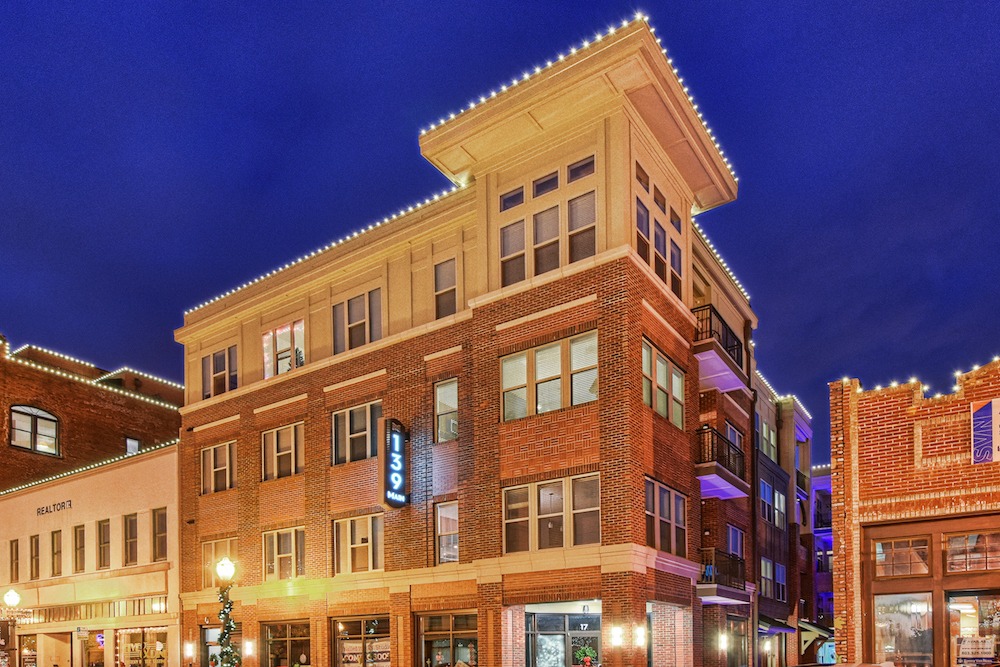Do not follow where the path may lead. Go instead where there is no path and leave a trail.
-Ralph Waldo Emerson
If you were to visit downtown Rock Hill, South Carolina, you might find yourself in the Freedom Walkway, walking on bands of red and cocoa clay pavers from Pine Hall Brick Company, laid into a running bond pattern that stops short to turn into a basket weave pattern at gathering spots.
The design is intended to get visitors to pause for a moment and consider what happened on this spot more than 50 years ago, when students from a historically black private junior college took matters in their own hands.
What happened here is best described by what you would see if you looked up. There’s a red brick wall there, emblazoned with the words, “Liberty and Justice For All.”
It’s a hardscape design that tells a story.
Standing up for a cause by sitting down
The Freedom Walkway is about the sit-in, an often-used method of civil disobedience in the Civil Rights Movement of the 1960s. Black college students adopted the method of head-on confrontations by going to segregated lunch counters and ordering food. When they were refused, they would stay seated and end up under arrest.

Bolstered by a sit-in in February 1960 by four N.C. A&T State students at the Woolworth’s in downtown Greensboro, NC, http://www.library.ncat.edu/resources/archives/four.html. There had been sit-ins in the past, but the actions by the students in Greensboro served as a springboard for other protests and brought the idea of segregation into the national consciousness. The movement spread to 250 cities across the US by the end of that month and 400 by the end of the year.
Here in Rock Hill, in January 1961, the Friendship Nine – https://en.wikipedia.org/wiki/Friendship_Nine– so named because eight of the nine were students at Friendship Junior College – integrated a whites-only lunch counter at the McCrory’s department store in Rock Hill. Like Greensboro, they added a needed boost to the movement but with a new wrinkle.
They opted to spend time in jail, rather than pay a fine that would effectively support a system that they saw as unjust. Because the sit-ins were continuing to expand throughout the South, protesters who chose to serve time saved the money that civil rights groups would otherwise have to pay for court fines – and that new strategy again invigorated the movement as it spread across the country. It was a policy that would later be adopted by the Freedom Riders, college students who traveled to the South to help blacks register to vote.
More than 50 years later, in 2015, Judge John C. Hayes III of Rock Hill overturned the convictions of the nine, saying “We cannot rewrite history but we can right history.” A prosecutor apologized to the eight men who were still living, who were in court.
Opening a book – and a new chapter
City governments, colleges and commercial real estate developers often call on hardscape design to tell a story. Before they do, it’s the job of landscape architects to research the story and come up with a design that communicates what the story is and how to best tell it, not in terms of words and pictures, but in the use of elements like clay pavers and wall art, seating and lighting and appropriate public art like sculptures or mosaics. It’s challenging for any landscape architect; more so when the architect involved is in a solo practice.
Laurel Holtzapple,a Charlotte, NC-based solo landscape architect and principal of Groundworks Studio http://groundworksstudio.com/, which oversaw the project, said she first learned about what would become Freedom Walkway through a request for qualifications from the City of Rock Hill. She assembled a team, which included Lauren Doran and Haoting Shi; then brought in Juan Logan, a painter, sculptor and expert in public art. The team was shortlisted, interviewed and then got the job.
“It really was a compressed schedule, because we had three months to do the community engagement and conceptual design,” said Holtzapple. “We began engaging with the students of Rock Hill and within community meetings, but our real focus was on civil rights arts projects.”
Some of the design came out of the community in unexpected ways. During the time that the design was being written, the 2015 court hearing – the reopening of the court docket book and the overturning of the trespassing convictions – occurred and found its way into part of the design for Freedom Walkway.
Presentations to the community and to the City Council followed. Preliminary approval was granted and bids were let for civil and structural engineering, for electrical engineering and lighting design and for general contracting. The city came back to Holtzapple to ask who would be able to execute the artistic elements – and Holtzapple recruited Carrie Gault to handle the mosaics and Sharon Dowell to paint the mural.
The biggest challenge was the relatively small size of the project itself. Freedom Walkway is 12 feet wide at its narrowest point and as it was being built, 139 Main, an apartment and retail complex, was being built immediately next to it, which meant there were two construction sites with two very different projects going on simultaneously.
Landscape architects need to be both quick and nimble, especially in such close quarters. That was proven the day that a brick tumbled off a scaffolding area and came uncomfortably close to testing the effectiveness of the hard hat that Holtzapple was wearing.
“It was all of the things that you would have in a big project, but concentrated in a tiny little space,” said Holtzapple.
The takeaways from Holtzapple’s perspective included:
- An ability to communicate. In designing a hardscape project, make sure all voices are heard, including the community and the client.
- A sense of urgency. Find the client and move quickly to get the job and carry it out.
- A knowledge of local talent. When working solo, know who else in the community that you can call on.
As it worked out, the project was carried out the way that a lot of business is done in a lot of different business categories these days: Instead of having all of the functions done by one individual, it was successfully completed by finding ways to collaborate across specialties, ensuring work for all involved.
“Gone are the days of the Renaissance man,” said Holtzapple. “It is the age of specialization. Things are so complex that it is best for you to know your area and know who works in allied professions, so you can rely on a highly qualified team to get the job done.”
How it came together
The project had its beginnings in a deteriorated former Woolworth’s building, not far from the McCrory’s where the Friendship 9 sit-in took place. The Woolworth’s was built in 1916, burned in 1934 and rebuilt in 1935. By 2014, damage to the roof had left it too dilapidated to restore. A proposal to demolish the building for a mix of retail and apartments – and a public walkway connecting a parking lot to the business district – was approved.
Holtzapple and Groundworks Studio held a number of public meetings to gather ideas for the project. As it turned out, some of the design was already there.
Once uncovered, an exterior brick wall covered with layers of paint from past advertisements provided a backdrop to the Freedom Walkway. Some – like the word “Relieves Fatigue” – were kept as a symbolic reminder of the struggles of the Civil Rights Movement.
The words “Liberty and Justice For All,” were added to the wall, from an old photograph of a protester’s sign. A chimney from the Woolworth’s building was painted dark blue, a color that has traditionally symbolized protection in the African-American community and is lighted at night, as a beacon of hope.

On the ground, curving patterns of clay pavers flow through the walkway, leading visitors on a journey. The nine cylinders of gray granite represent the stools that the Friendship 9 sat on; swirling blue spiral mosaic patterns within the field of pavers represent the turbulence of the era; the boulders within the walkway represent obstacles in the path of those seeking freedom and justice.
Even the patterns of the clay pavers themselves are symbolic: the running bond directs forward movement and directs visitors through the area, the basket weave is symbolic of the patterns of the baskets that the nearby Catawba Indians make. The craftsmanship at the site was carried out by Holtzapple and Juan Logan, artists; Carrie Gault, mosaics; and Sharon Dowell, who painted the mural.
In all, the Freedom Walkway is a work in progress, much as the Civil Rights Movement was and is. Those involved in the project say that it shows where we have been, where we are now and where we hope to be in the future.
And the meaning of this place, the reversal of an earlier conviction in light of attitudes that have changed over five decades, echoes a speech given by an unknown slave preacher, which was quoted by Rev. Martin Luther King Jr. in 1962.
King himself said the comments weren’t grammatically correct but were profound.
They were:
“Lord, we ain’t what we oughta be. We ain’t what we want to be. We ain’t what we gonna be. But, thank God, we ain’t what we was.”
The author, Walt Steele, is paver business manager for Pine Hall Brick Company, America’s largest manufacturer of genuine clay pavers. For more information, Steele can be reached at (800) 334-8689 and by email at waltsteele@pinehallbrick.com. For more information, please visit www.PineHallBrick.com
Rock Hill’s Freedom Walkway was supported by grants from the National Endowment of the Arts, the Arts Council of York County and the Barre Mitchell Community Initiatives Fund. It was awarded a 2017 ASLA Southeast Merit Design Award and a 2017 Cultural Diversity Award by the National League of Cities. Watch a video of the project’s process here: https://youtu.be/LfpcyjkNVcE

